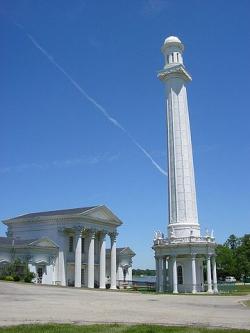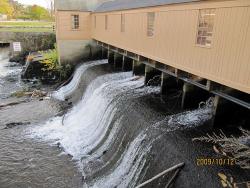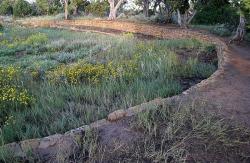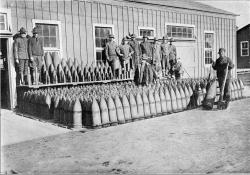This run-of-the-river plant is a typical example of late nineteenth-century small-scale (750 kilowatt) low-head hydroelectric power technology. The Fries Manufacturing and Power Company began operating the Idol's Station on April 18, 1898, making it the first commercial hydroelectric plant in North Carolina involving long-distance power transmission, fourteen-miles distance at 10,000 volts. Idol's was an important power source for transportation, lighting, and industry in the Winston-Salem area.
USA

This machine, which began operation on December 15, 1891, for the New York Edison Illuminating Company, represents the beginning of large-scale electric power generation in the United States. The generator was designed by chief engineer John Van Vleck, David Joy (known in England for his valve gear), and S. F. Prest.

In the mid-1800s Virginia City was America's greatest producer of high-grade silver and gold ore. When mining activities began, natural springs provided water to the camps. As the population grew, the Virginia and Gold Hill Water Company was formed to address the need for more water. The company first drew water from tunnels that had been driven into the mountains by prospectors. Water was stored in wooden tanks and sent through pipes into the town.

People thought inventor Walter Aiken was crazy when he proposed a railway to the top of Mt. Washington. Aiken built a model of the roadbed and track with a cog rail system, but entrepreneur Sylvester Marsh is credited for launching the Cog Railway and bringing Aiken's ideas to fruition.
In 1858 Marsh applied to the New Hampshire Legislature for a charter to build and operate the steam railway and was granted permission in 1859. Legend has it that an amendment was added offering permission to extend the railway to the moon.

Most of the locks were 184 feet long and 36 feet wide, able to handle boats up to 160 feet long. The sandstone locks (along with wood miter gates, rock-filled timber-crib dams and bypass canals with guard gates) created a slackwater navigation system stretching over 90 miles.

In the 18th century, French architect Claude-Nichols Ledoux was known for forging architectural beauty with industrial efficiency. One hundred years later his vision was given new life through the design of the Louisville Water Company Pumping Station.

Much of the sophisticated system of canals, dams, gates, and tunnels built to manage water power in 19th-century Lowell is preserved today as the basis of the Lowell National Historical Park and the Lowell Heritage State Park. Pictured above is the Boott Penstock, an early channel adjacent to the Boott Mills (right).

Visionary Alexander Hamilton, the United States' first Secretary of the Treasury, visited the Great Falls of the Passaic River with George Washington in 1778. The 77-foot-high, 280-foot-wide waterfall inspired his dream of abundant, inexpensive energy as the means for economic independence from foreign markets.

Four prehistoric reservoirs at Mesa Verde National Park were constructed and used between AD 750 and AD 1180. They are: Morefield Reservoir (in Morefield Canyon), Far View Reservoir (on Chapin Mesa), Sagebrush Reservoir (on an unnamed mesa), and Box Elder Reservoir (in Prater Canyon). These four ancient reservoirs represent extraordinary engineering achievements by the Ancestral Puebloan people. In an arid environment with very little surface water, these prehistoric people found ways to route and capture runoff to create sustainable domestic water supply reservoirs.

During the 1930's, research into advanced ballistic measurement techniques began at Aberdeen Proving Ground—the world's first large-scale, fully-instrumented ballistic range producing data on the aerodynamic characteristics of missiles in free flight.


